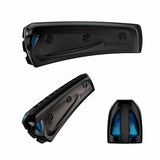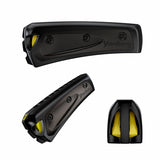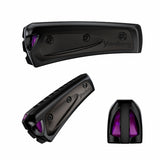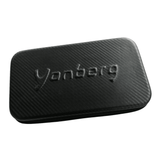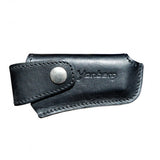This is an interesting harmonica, to be sure. Back in the day, we'd have called it "hi tech". Very sleek looking, modern shape, mostly black with black chrome panels. It feels almost slippery and smooth in the hand. Reminds me of the old BMW ads, saying they felt like they were carved out of a solid block. But most of that block is still plastic.
Even with the titanium replacing brass, the Typhoon is heavier than a Hohner Crossover; half an ounce heavier than one with a Zajac comb (which is itself heavier than the stock bamboo). It's also bigger; the narrowest end is the size of a Crossover, the wider end about 60% larger. The Typhoon is thicker than the Zajac Crossover (Zajac combs are also thicker than stock bamboo combs). The harp feels good to hold, but is definitely large.
I find the playability weird. The airflow seems very "free" compared to a comparable Crossover (both in C). Maybe it's the comb material, maybe it's the unique shape of the slots in the comb (the sides and end are a bit curved, more like a goblet than a rectangular box). The reeds seem very responsive and vibrate smoothly with very little air. It doesn't feel or sound at all airy; very tight. However...... this 'ease of playability' kind of makes it feel like a toy. Somehow the combination of little air resistance, quick but quiet sound (it's much quieter than a Crossover), and the oversize thickness makes it feel like a Fisher Price harmonica for toddlers. Or maybe like a super professional, high tech monster that plays like nothing you've ever tried. I can't tell which.
All the reeds play their marked tones easily, clearly, and sweetly. I personally have trouble with bending notes on it, though, and that's not usually a problem. Specifically, a 2-draw bend is tough to get, tough to maintain, and usually involves a terrible warbling or clacking sound when it finally happens. It's entirely possible that this is due to my own poor technique, highlighted by the titanium reeds. Trying to do a 2-draw bend on this C harp feels like doing the same on a high F harp, back when I first got one. For me, 2-draws get easier as the key goes up, until I got an F... that felt entirely different, and so does this one. Mouth shape and airflow are just different from most. I also have real trouble with a 1-draw bend; I simply cannot get it down a full 1/2 step. This feels to me similar to doing a 1-draw bend on a *low* F harp... no matter how low I drop my jaw and how hard I pull, I can't get more than a weak dip in pitch. Again... this may be showing how bad my technique is. This is *nothing* like my experience with a normal C harp. 8/9/10 blow bends seem OK; I can easily get the 8/9, but the 10 is hit-or-miss. Sometimes it dips every time, sometimes I can't get it to bend no matter what. Again, not nearly what I experience on a normal brass reed C harp.
The assembly system is unique. I like the idea of using only three larger screw fasteners with the nuts embedded in the cover plate. But I just don't trust the four small plastic levers that are used to hold the reed plates in place. Maybe it's a very robust and stable plastic and the hinges will hold up fine. But most plastics are *not* that good, and tiny plastic hinges meant to exert a pretty large clamping pressure over a long time doesn't seem that great of a plan. Time will tell.
This is obviously a very expensive instrument. It may very well be a superb machine, and I'm an unworthy hack who's unable to take advantage of it's subtle benefits. Or it's a so-so gimmick. Either way, it's quite a lesson.







